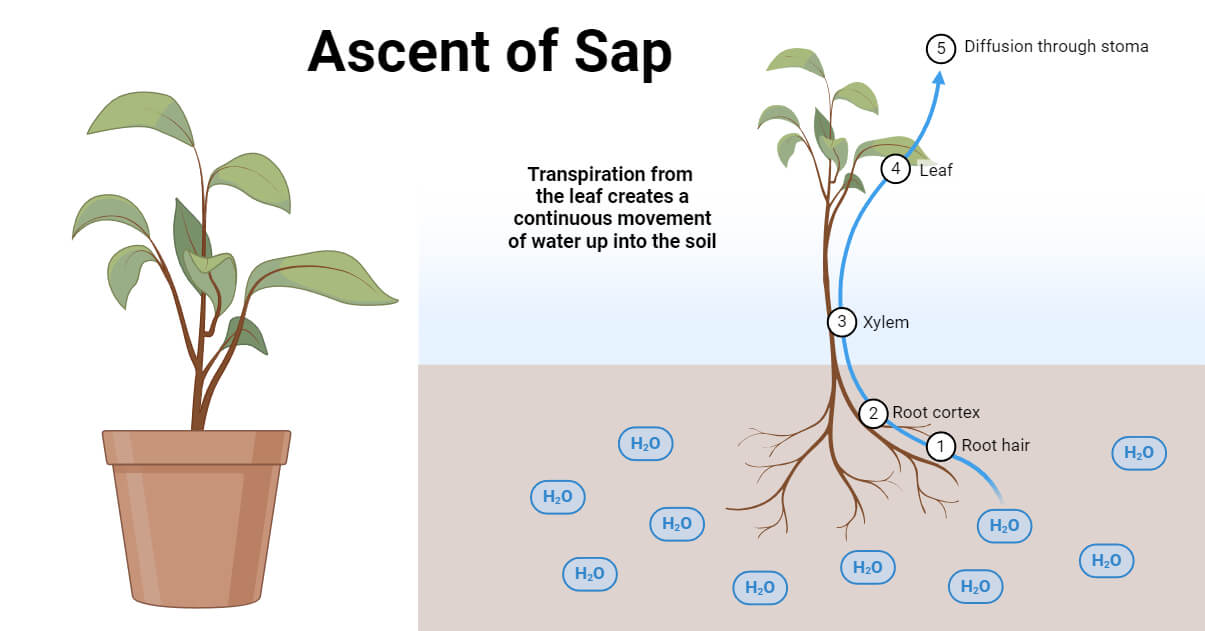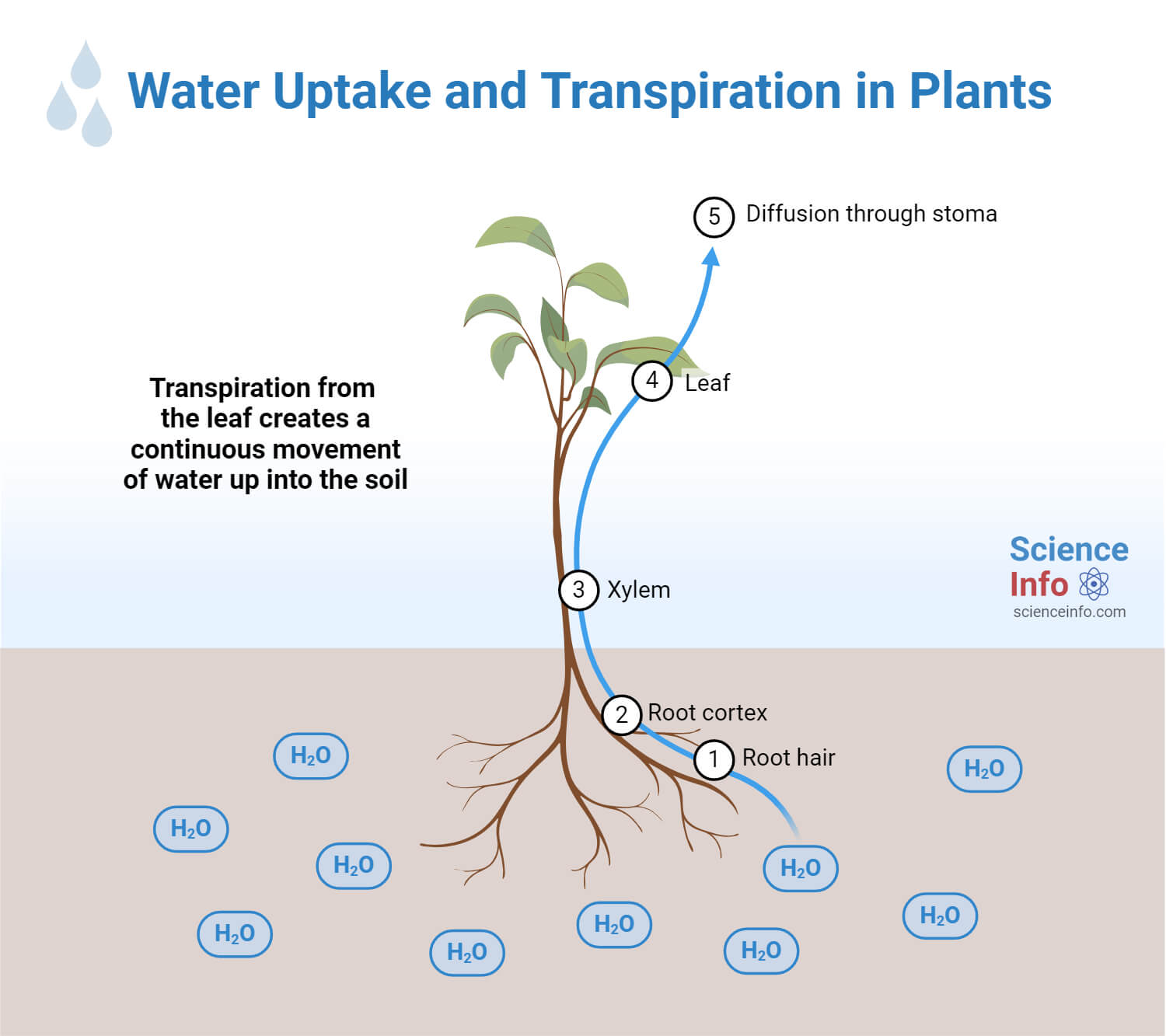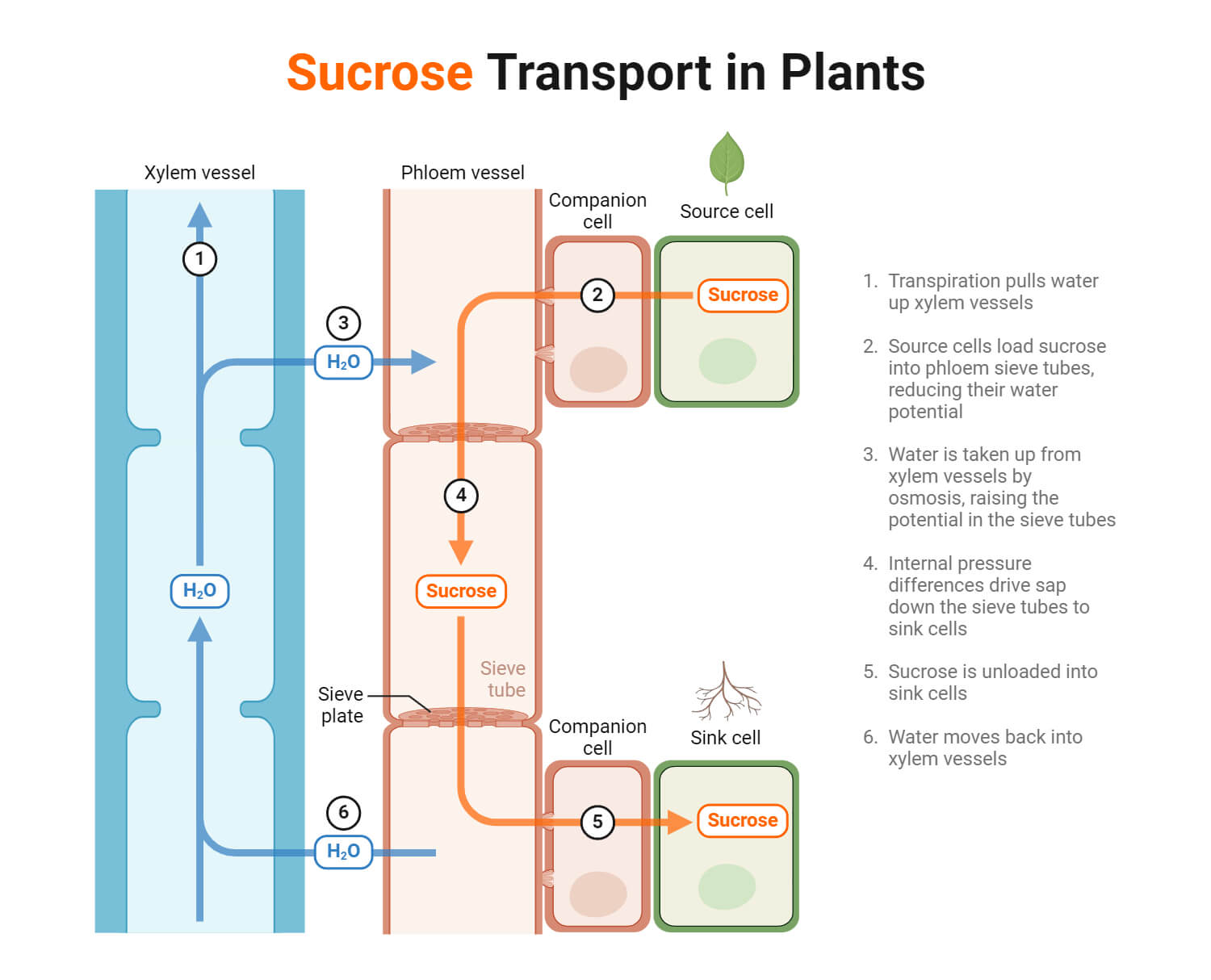Ascent of Sap is the upward movement of water and dissolved inorganic particles from the roots to the leaves through the xylem tissue against gravity.
Sap is the water and dissolved inorganic substances that roots take up from the soil and distribute throughout their body.

Interesting Science Videos
Mechanisms of ascent of sap
Various theories have been proposed to explain the mechanism of the ascent of sap. These theories can be grouped under three categories:
- Vital force theories
- Root pressure theory
- Physical force theories
1. Vital Force Theories
These hypotheses propose that the ascent of SAP in the plant body occurs due to the activities of the living cells present in the plant body. The following theories have been proposed in support of it.
- Westermaier’s theory
- Godlewski’s theory or Relay Pump Theory
- Pulsation theory
a. Westermaier’s theory:
Westermaier proposed this theory. According to this theory, the activity of xylem parenchyma cells is responsible for the ascent of sap in the plant body. The xylem vessels and tracheid act as water reservoirs.
b. Godlewski’s theory or Relay Pump theory:
Godlewski proposed this theory. The living xylem parenchyma cells and medullary ray cells are responsible for the ascent of sap in the plants. These cells take up water from the xylem vessel at a particular level and pump it back into the xylem vessel at a higher level. As a result of this ongoing process, the sap finally reaches the top of the tree. Here, the xylem vessels and tracheid act as a reservoir. This theory is also known as the relay pump theory because the living cells act like a relay pump.
c. Pulsation theory:
Sir Jagadish Chandra Bose proposed this theory. The ascent of sap in the plant body occurs due to the pulsatory activities of the cells in the innermost layer of the cortex, just outside the endodermis. As these cells take up water, they expand. When the expanded cells contract, the sap is pumped to the next higher cell, and the process continues. The sap finally reaches the top of the tree.
Objections to vital force theories:
Strasburger demonstrated that the ascent of sap continues to occur even after killing living cells. The living plant cells were killed by dipping the plant organs in boiling water or strong citric acid.
2. Root Pressure Theory
This theory was proposed by Priestly. The ascent of sap occurs due to the root pressure developed in the root. The phenomenon of root pressure was first discovered by Stephen Hales and the term ‘root pressure’ was also coined by him. Root pressure is defined as a sort of hydrostatic pressure developed in the roots due to the excessive accumulation of water in the root.
The mechanism of generation of root pressure and its role in causing the ascent of sap is explained below:
The water potential of capillary water present in the soil is higher compared the that of the cell sap of root hair cells. These two regions are separated by a semipermeable cell membrane of the root hair cell and so, osmosis is set up between the two. The capillary water enters the root hair cells and its water potential increases. Later, the water potential of root hair cells becomes higher than that of the inner cortical cells. So, through osmosis, water enters the cortical cell from the root hair cells. This process of osmosis continues from one cortical cell to the next cortical cell till all the cortical cells become turgid. When the cortical cells take up water, they become turgid and when they give water, they become flaccid. Thus, intermittent jumping action caused by the alternating flaccidity and turgidity of the cortical cells gives rise to root pressure which causes the ascent of sap in plants.
Objections to Root Pressure Theory:
- The root pressure measure in plants is recorded to be less than +2 atm. It is nearly not enough pressure to cause the ascent of sap up to a height of less than 20m as 1atm is capable of lifting water to a height of 10m.
- Root pressure is observed only during the rainy season.
- Root pressure is not present in gymnosperms, a group that includes some of the tallest trees on the planet.
- Sap ascends even when root pressure is entirely lacking.
- Sap ascends even when there is a total absence of roots.
- In rapidly transpiring plants, the root pressure is negative.
3. Physical force Theories
Physical force theories propose that the upward movement of sap within the plant is driven by a range of physical forces acting within the plant’s structure. The following theories have been proposed in support of it:
- Capillary force theory
- Atmospheric pressure theory
- Imbibition theory
- Transpiration Pull theory or Cohesion-tension theory or Dixon-Joly theory
a. Capillary Force Theory:
Boehm proposed this theory. According to this theory, the xylem vessels occur in the form of narrow capillary tubes extending from the roots up to the top of the plant body. The capillary forces generated in the capillary tube help in the ascent of sap.
Objections to Capillary Force Theory:
- The average diameter of xylem vessels recorded in a plant is 0.03mm. A xylem vessel with a bore of 0.02mm is capable of lifting water to a maximum height of 150cm. Therefore, it fails to explain how sap ascends in tall trees.
- The narrower the bore of the capillary tube, the higher the rise in water level. This indicates that the tallest trees should have xylem vessels with the narrowest bore. However, anatomical findings don’t tally with it.
- To initiate capillary action one end of the capillary tube must be fully submerged in water. However, this situation doesn’t occur as the xylem vessels end in parenchyma cells or remain surrounded by cells.
b. Atmospheric Pressure Theory:
According to this theory, due to rapid and continuous transpiration from the upper aerial portion of the plant body, particularly the leaves, a vacuum is created in the leaf. To fill this vacuum, the atmospheric pressure lifts water causing the ascent of sap.
Objections to Atmospheric Pressure Theory:
- Atmospheric pressure can lift water to a maximum height of 10m and cannot account for the ascent of sap in taller trees.
- According to this theory, a vacuum is created. However, to date, no vacuum has been discovered.
- For atmospheric pressure to exert its influence, there must be free a surface at the lower end of the plant body. But this condition doesn’t occur.
c. Imbibition Theory:
This theory was proposed by Unger and Sachs. According to this theory, the plant body and the wall of the lumen are rich in hydrophilic colloids. These colloids help in the imbibition of water causing the ascent of sap. Imbibition is a form of diffusion that leads to a rise in volume due to water absorption by colloids.
Objections to Imbibition Theory:
- Imbibition is a very slow process and it can’t explain the tremendous amounts of water lost from the aerial portion of the plant body through transpiration.
- It is already proved that the ascent of sap occurs through the lumen of the xylem vessels and not through the walls of the xylem.
d. Transpiration Pull Theory:
This theory was proposed by Dixon and Joly This theory is widely acknowledged as the most favored explanation for how sap moves upward in plants. According to this theory, the water molecules that were together due to strong cohesive forces form into a long continuous water column in xylem vessels, extending from the root to the leaves. This cohesive force along with the adhesive force which exists between the water molecules and the walls of the xylem vessels prevents the water column from breaking even under a state of high tension caused due to transpiration pull.

Due to rapid transpiration from the mesophyll cells of the leaves, the mesophyll cells lose water to the external atmosphere. This causes an increase in the osmotic pressure of the mesophyll cells so; the mesophyll cells draw water from the nearby mesophyll cells of lower osmotic pressure by osmosis. This process of osmosis continues from one mesophyll cell to the next mesophyll of the leaf and thus, an osmotic gradient is built across the leaf. The deficit of water in the terminal cell of this gradient is fulfilled by drawing water from the xylem vessels. When many such vessels take up water from the xylem vessels, a strong suction force called transpiration pull is developed which pulls the water column upward causing the ascent of sap. The transpiration pull creates a negative pressure called tension in the sap of xylem vessels. This tension developed in the xylem vessels of the leaf is transmitted to the xylem vessels of the root via the xylem of the shoot. This causes a decrease in the water potential of the root cells and so the root cells continuously draw water from the soil.
Evidence in support of Transpiration Pull Theory:
- It is found that the ascent of sap is directly proportional to the rate of transpiration.
- The magnitude of the osmotic pressure of the mesophyll cells of leaves has been recorded up to 20atm which is quite sufficient for the ascent of sap as 1atm is capable of lifting water to a maximum height of 10m.
- The magnitude of the cohesive force of water is about 300atm which is quite sufficient for the ascent of sap as the cohesive force required for the ascent of sap to the tip of the tallest tree is about 30atm.
- It is a purely physical process that doesn’t require expenditure of energy. If energy is required, it is very negligible.
- The strongest evidence in support of this theory is provided by the porous pot experiment.

Factors affecting the ascent of sap
- Water absorption: The rate of ascent of sap is directly proportional to the amount of water absorbed by roots.
- Transpiration: It is the main physiological process that is responsible for the ascent of sap. The higher the rate of transpiration, the higher the upward movement of sap.
- Temperature: High temperature increases the rate of the ascent of sap.
- Concentration of soil solution: The high concentration of soil reduces the rate of ascent of sap by reducing absorption.
- Availability of water: The availability of water in the soil is directly proportional to the rate of water absorption and ascent of sap.
- Soil condition: Soil, air, water, and temperature directly influence the rate of absorption of water and thereby the ascent of sap.
Imbibition
The phenomenon of swelling up of the solid or semisolid substance due to the adsorption of water molecules by the hydrophilic colloids present in it. Examples: swelling up of dry wood, dry gum, dry seed when soaked in water, swelling up of rubber when placed in kerosene.
Imbibant:
The solid or semi-solid substance that imbibes water during the process of imbibition is called imbibant. Examples: swollen-up dry wood, dry gum, dry seeds, etc.
Imbibate:
The liquid substance which gets imbibed into the imbibant during the process of imbibition is called imbibate. Examples: water, kerosene, etc.
In the plant body, imbibants are the hydrophilic colloids like cellulose, pectin, starch, protein, and the imbibate is water. During the process of imbibition, the volume of the imbibant increases. However, the volume of the system (Volume of imbibant + volume of imbibate) decreases. This decrease is due to the tightly binding of the imbibate molecules onto the imbibant which decreases the intermolecular distance of the imbibate molecules. In the imbibition process, water molecules, previously in a state of continual and random movement (with kinetic energy), become firmly bound by the imbibing substance, leading to the release of their kinetic energy as heat. This heat released during imbibition is called heat of wetting. The pressure developed due to the process of imbibition is called imbibitional pressure.
References
- The ascent of sap in plants – ScienceDirect
- New Theory for the Ascent of Sap—Cohesion Supported by Tissue Pressure | Annals of Botany | Oxford Academic (oup.com)
- Ascent of sap (panchakotmv.ac.in)
- Cohesion hypothesis | Definition, Botany, Mechanism, & Facts | Britannica
- Transpiration Pull – Overview, Types, Process and Roles (vedantu.com)
- Root Pressure Theory by Unacademy
- Ascent of Sap: Learn Important Concepts – Embibe
- Xylem Structure and the Ascent of Sap – M.H. Zimmermann – Google Books
- Theories-of-Ascent-of-Sap.pdf (usp.br)
- Biology : Online Labs for schools – Developed by Amrita Vishwa Vidyapeetham and CDAC Online Lab (olabs.edu.in)
